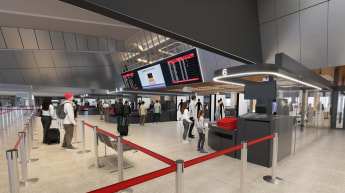
The search for Missing Malaysia Airlines flight MH370 will resume shortly after the Malaysian government formally accepted an offer from private company Ocean Infinity to find the aircraft on a “no cure, no fee” basis.
Malaysia Transport Minister Liow Tiong Lai and Ocean Infinity chief executive Oliver Plunkett officially signed the contact in Kuala Lumpur on January 10, which will see the US-based company undertake a 90-day search for the Boeing 777-200ER, which disappeared en route from Kuala Lumpur to Beijing on March 8 2014 carrying 239 passengers and crew.
Malaysia TV channel TV3 showed highlights of the signing ceremony on Twitter.
PUTRAJAYA: Menteri Pengangkutan, Datuk Seri Liow Tiong Lai menyaksikan Majlis Menandatangani Kontrak Misi Pencarian Lanjut MH370 antara kerajaan Malaysia dan Ocean Infinity Limited. pic.twitter.com/cWEakPi3VE
— Buletin TV3 (@BuletinTV3) January 10, 2018
One of Ocean Infinity’s search search vessels, the Seabed Constructor, a leased research vessel, was already close to the search area, having been despatched from Durban in South Africa in early January in anticipation of the deal being accepted. The search was expected to officially commence on January 17
Ocean Infinity said the search would focus initially on a 25,000 sq km zone identified by Australian Transport Safety Bureau (ATSB) reports.
“We are pleased that our offer to continue the search for missing Malaysian Airlines flight MH370 has been accepted by the Government of Malaysia, who I would like to thank for giving us the opportunity,” Plunkett said in a statement.
“Whilst there can be no guarantees of locating the aircraft, we believe our system of multiple autonomous vehicles working simultaneously is well suited to the task at hand.
“I wish our team the best of luck in their endeavours and sincerely hope that we will be able to play a part in providing some answers to the many people affected by this tragedy.”
Liow said Ocean Infinity’s primary mission under the “no cure, no fee” contract was to locate the wreckage and/or the flight date recorder and cockpit voice recorder during the 90-day search period within a 25,000 sq km search area.
“OI must also present considerable & credible evidence to confirm exact location of d two main items,” Liow said on Twitter.The primary mission by @Ocean__Infinity is to identify location of wreckage and/or both of the flight recorders; Cockpit Voice Recorder (CVR) n Flight Data Recorder (FDR). OI must also present considerable & credible evidence to confirm exact location of d two main items. #MH370 https://t.co/x36MGQvtHB
— Liow Tiong Lai (@liowtionglai) January 10, 2018
Under the “no cure, no fee” arrangement, Ocean Infinity stands to receive US$20 million if it finds the debris or recorders within the first 5,000 sq km of the search area.
Further, the company is eligible to receive US$30 million for anything found within the next 10,000 sq km, and US$50 million for the outer most area of 10,000 sq km.
Finally, Ocean Infinity will be paid US$70 million should it find anything substantial beyond the designated search area. All payments will be made by the Malaysian government.
Ocean Infinity said it had up to eight Autonomous Underwater Vehicles (AUVs) – equipped with side scan sonar, multi-beam echosounder, sub-bottom profiler, HD camera, conductivity/temperature/depth sensor, self-compensating magnetometer, synthetic aperture sonar and a turbidity sensor – capable of operating in water depths from 5m to 6,000m.
“The AUVs are ‘free flying’, which means they will not be tethered to the offshore vessel during operations,” Ocean Infinity said.
“The ability to operate untethered independent missions allows the AUVs to go deeper and collect higher quality data, making this technology ideal for the search.”
The Malaysian Ministry of Transport said on Twitter it hoped this latest search would “find the answers that we seek and bring some closure to the families and loved ones of #MH370 passengers & crew”.
“We stand with them in these trying times,” the Ministry of Transport said.It is our hope that with this latest search by @Ocean__Infinity, we will find the answers that we seek and bring some closure to the families and loved ones of #MH370 passengers & crew. We stand with them in these trying times. pic.twitter.com/Ial60sIL81
— M.O.T Malaysia (@MOTMalaysia) January 11, 2018
A search of 120,000 square kilometres in the Indian Ocean conducted by the Australian, Chinese and Malaysian governments ended in January 2017 without the aircraft being found.
Since then, the Australian Transport Safety Bureau (ATSB) published two reports prepared by Geoscience Australia and the CSIRO analysing satellite imagery taken some two weeks after the flight went missing.
The imagery, obtained from French authorities, identified 12 objects that were “probably” manmade, as well 28 items that were “possibly” manmade.
The reports, published in August 2017, said the movements of these items during the following three and a bit years due to ocean drift was determined using data from several types of earth-observation satellites, as well as Australia’s most powerful super-computer and more than a decade of government investment in operational ocean modelling.














